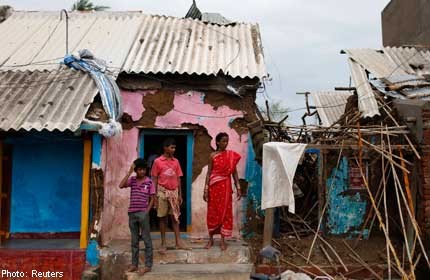Thousands homeless after killer Indian cyclone

GOPALPUR - Tens of thousands of people who fled India's strongest cyclone in 14 years returned to discover their homes and livelihoods destroyed Monday, as a massive relief operation kicked into gear.
One million people were forced to seek refuge in shelters and government buildings after the terrifying cyclone struck eastern India on Saturday, killing at least 18 people and leaving a trail of destruction along the coast.
Cyclone Phailin was dissipating rapidly after pounding the states of Orissa and Andhra Pradesh, bringing winds of more than 200 kilometres an hour (125 miles per hour), uprooting trees, overturning trucks, and knocking out power lines.
Residents, some carrying their children and clutching bags of possessions, and who hours earlier were huddled in shelters, made their way back to their towns and villages fearing the worst.
"I left everything (behind) and when I came back nothing was here," said Bhagwan, 50, who uses one name, a coconut seller from the hard-hit Orissa town of Gopalpur, as he sat on the ground in front of his destroyed shop.
Some 600,000 people were left homeless in Orissa after the ferocious storm tore through thousands of villages, the state's special relief commissioner, Pradipta Kumar Mohapatra, told AFP.
Many were poor fishermen and farmers living in mud and thatched dwellings, including in the worst affected area around Gopalpur, where the eye of Phailin came ashore.
"I lost my house and also a small shaving shop, I lost everything," Janardan, 32, who uses one name, said from inside his tiny dwelling in Gopalpur. The cyclone collapsed the roof, leaving Janardan and his wife to begin the clean-up.
[[nid:50661]]
Seventeen people were killed in Orissa and one person further south in Andhra Pradesh, government and disaster management officials said.
"The 17 deaths were due to people being crushed by falling trees, walls, roofs," R.S. Gopalan, the senior state government official coordinating relief operations in Orissa, told AFP.
India's President Pranab Mukherjee expressed sadness late Sunday over those killed and urged authorities to provide speedy relief and rehabilitation to all families by the disaster.
But Mukherjee also congratulated relief officials on the "high level of preparedness" which seemed to have limited the number of casualties.
More than 8,000 people were killed in 1999 when a cyclone hit the same region, devastating crops and livestock. The area took years to recover.
This time, the massive evacuation operation, which officials said was the biggest in Indian history, appeared to have succeeded in minimising casualties.
But despite the low death toll, the cyclone left a trail of destruction and hundreds of workers from the country's National Disaster Response Force fanned out across the region, clearing away fallen trees, mangled power poles, and other debris, a statement said.
Other relief workers distributed food at shelters and treated the injured, while authorities worked to restore power and other services.
India's airforce deployed helicopters and transport aircraft to help supply food, water and medical supplies to those in need.
In a remarkable story of survival, 18 fishermen trapped four kilometres (2.4 miles) offshore in rough seas abandoned their trawler as the cyclone approached, the Press Trust of India reported.
The fishermen swam to shore and were discovered on Sunday before being taken to a local hospital near the port of Paradip in Orissa, state government officials were quoted by PTI as saying.
Some 1,000 people marooned by the storm surge in a village in Andhra Pradesh were also rescued by boat, a senior disaster response official told a press conference in New Delhi.
Officials in Orissa said 873,000 people moved before the cyclone made landfall on Saturday evening, while at least another 100,000 were evacuated in Andhra Pradesh. Residents were also evacuated from coastal regions of West Bengal state.
High-sided trucks lying on their sides were witness to the strength of the winds on the main highway south of Gopalpur, which was littered with uprooted trees and other debris.
Some of the deadliest storms in history have formed in the Bay of Bengal, including one in 1970 that killed hundreds of thousands of people in modern-day Bangladesh.